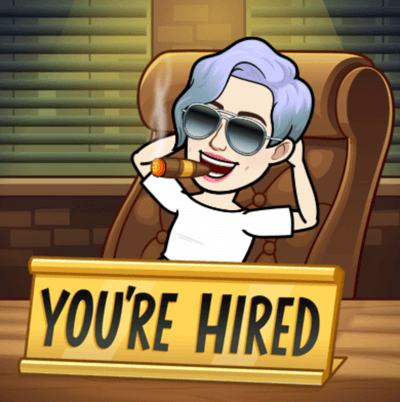Well, it’s finally happened. Bitmoji’s have made their way to corporate America.
In case you’ve been living under a social media rock for the last week, you probably saw the Wall Street Journal story about the emerging trend of job seekers putting Bitmoji’s on their resume as a way to stand out from the crowd.
Wait – what is a Bitmoji?
For those unfamiliar, a Bitmoji is a sticker feature available through Snapchat. Users can create a Bitmoji in their likeness and download images of the avatar doing anything from watering plants, to napping, to standing under a raincloud.
Turns out, some jobseekers are using Bitmoji's to try and stand out among the crowd. They are doing it in hopes that their quirky and unique personality will catch the eye of hiring managers and land them their dream job.

It's been a week since the initial story dropped and opinions are still divided on whether using a Bitmoji on a resume is the right way to show your personal brand or a wildly unprofessional gamble. The truth is you shouldn’t be putting a Bitmoji on your resume for one simple reason – applicant tracking systems.
What is an applicant tracking system?
An applicant tracking system, also known as ATS software, are the newest tech wave in the world of hiring and recruitment. It’s a computer program that scans your resume for keywords, job titles, and other relevant information to determine whether or not you’re a good fit for a job.
How many companies use applicant tracking systems?
According to recent data, as many as 90% of hiring companies are using applicant tracking systems to pre-screen candidates before the first interview.
That means your resume is being judged by an algorithm before a human ever sees it. Most job candidates don’t realize this and it’s costing them job opportunities left and right.
What does a Bitmoji on my resume have to do with ATS software?
While the technology behind applicant is sophisticated, it’s not perfect. These programs are designed to search for keywords and phrases, not graphs, photos, or design elements. If your resume has too many confusing elements, it can mean your resume will end up in the trash before the hiring manager ever sees it.
Sound harsh? It’s really not. ATS software wasn’t designed with Bitmoji’s in mind. The AI is programmed to discover if you know how to communicate that you can do the job. This means your resume should be less about the bells and whistles and more about the skills you have.
How to optimize your resume for ATS software
So, now that you know putting a Bitmoji on your resume is a bad idea (seriously, don’t do it), we can talk about the best way to optimize your resume to make it past ATS software. There’s no perfect formula for creating the perfect resume, but there are a few tips you should follow.
|
Tips for creating an ATS friendly resume
- Choose the right file type
- Don't put important details in the header or footer
- Optimize your resume with industry-specific keywords
- Use the job description to write your resume
- Avoid images, charts, and other graphics
- Avoid long form-rambling paragraphs
|
As the technology behind ATS software evolves, so will its level of sophistication. For now though, it’s probably best to focus on writing a resume that communicates your skills, rather than shows off your sense of humor.
There are smarter ways to stand out
It can be tempting to do something bold to stand out in such a competitive job market, but you need to be smart about how you do it. Try writing a unique cover letter that communicates why you’re the best person for the job or coming up with thoughtful questions you can ask in an interview. At least for the time being, leave the Bitmoji at the door.

 by Lauren Pope
by Lauren Pope
 by Liz Strikwerda
by Liz Strikwerda